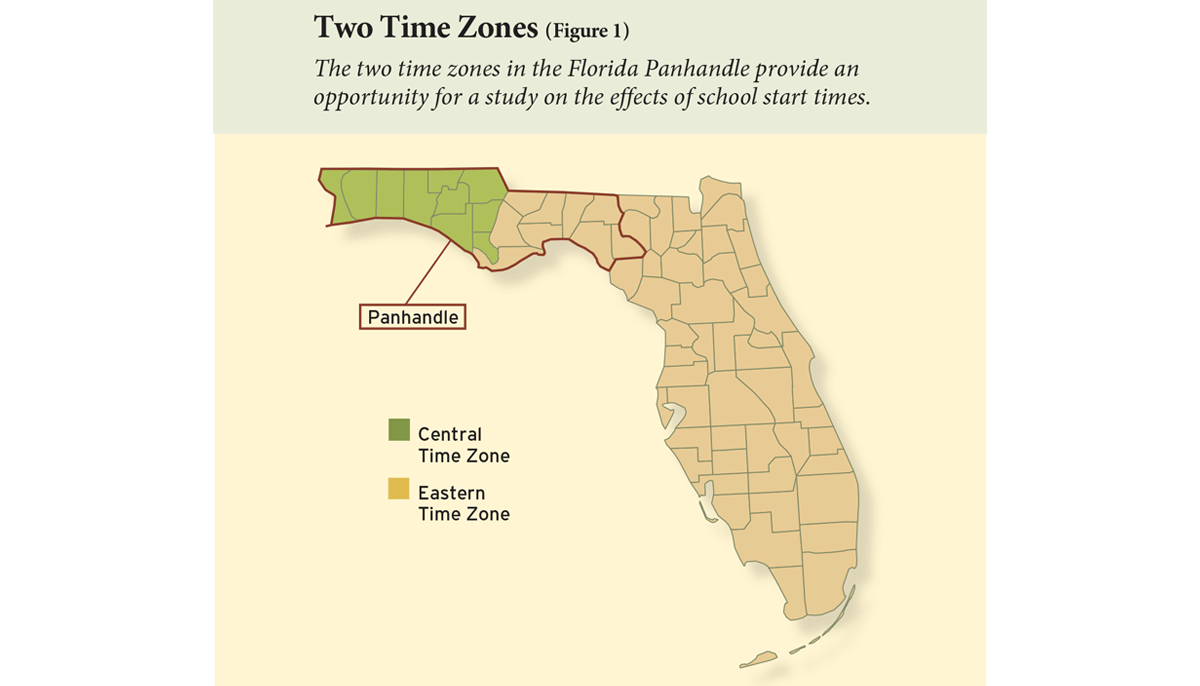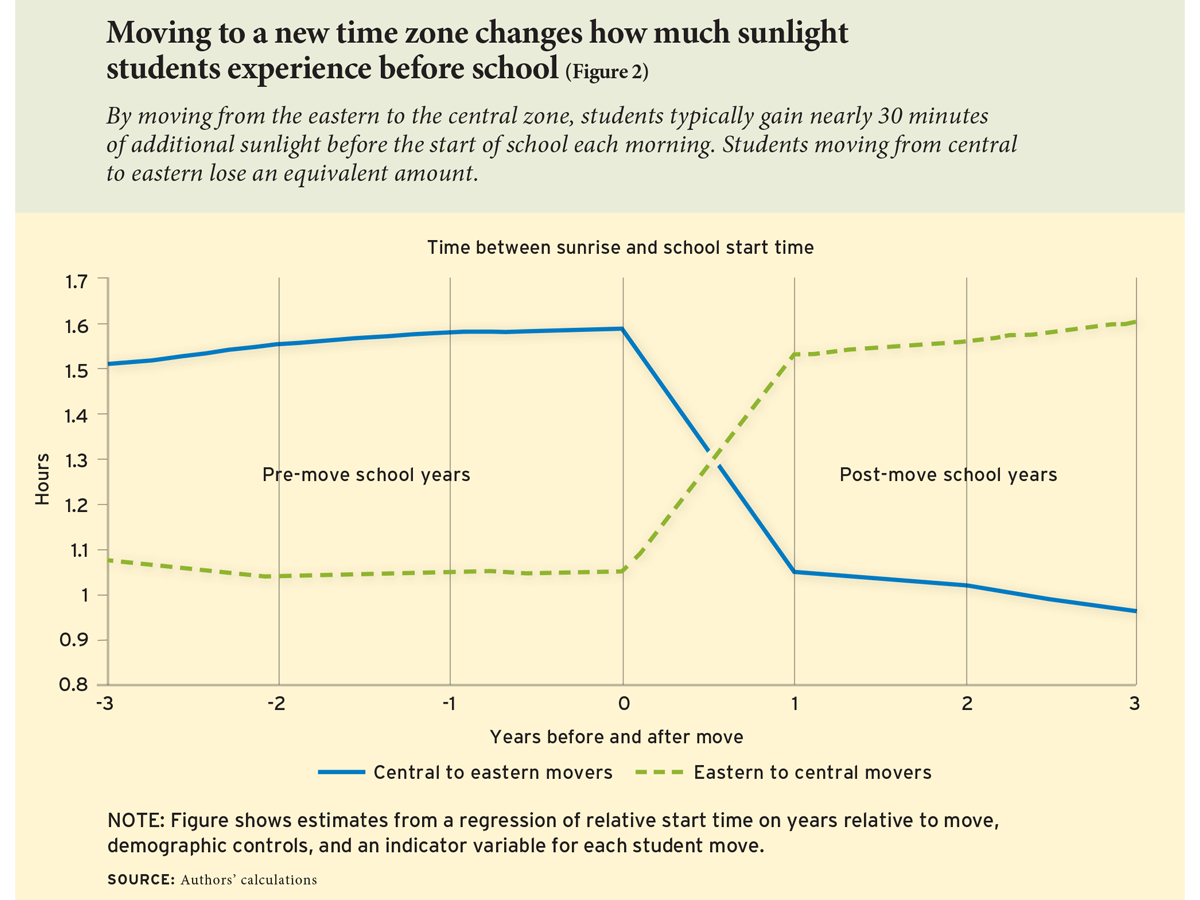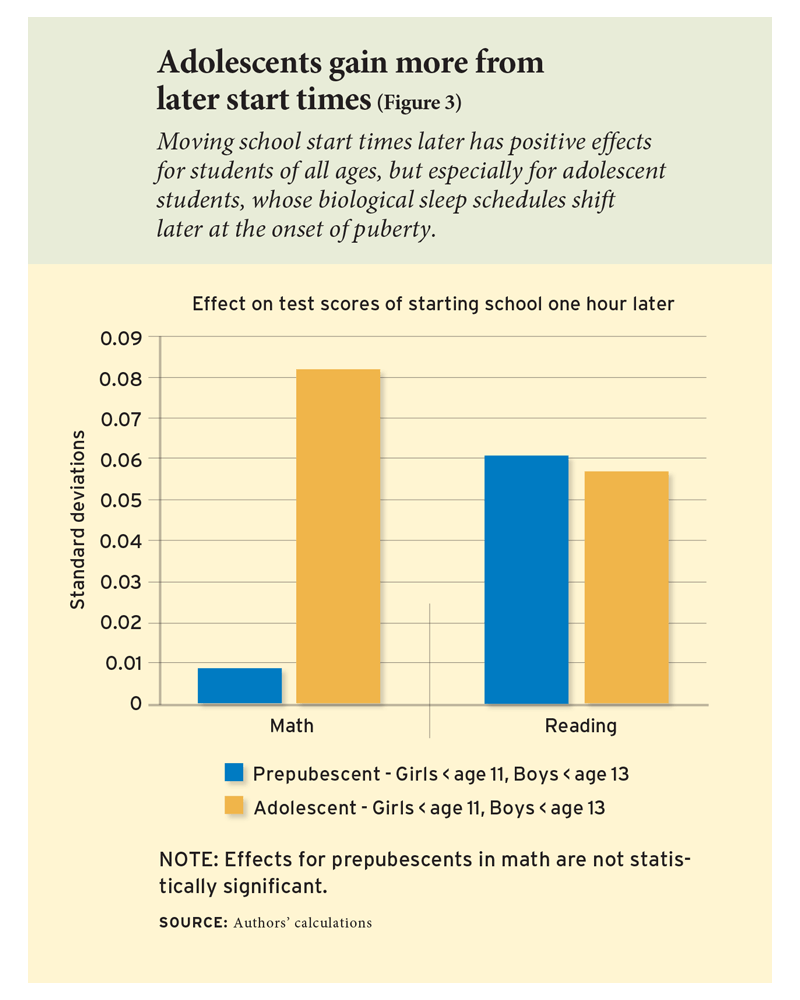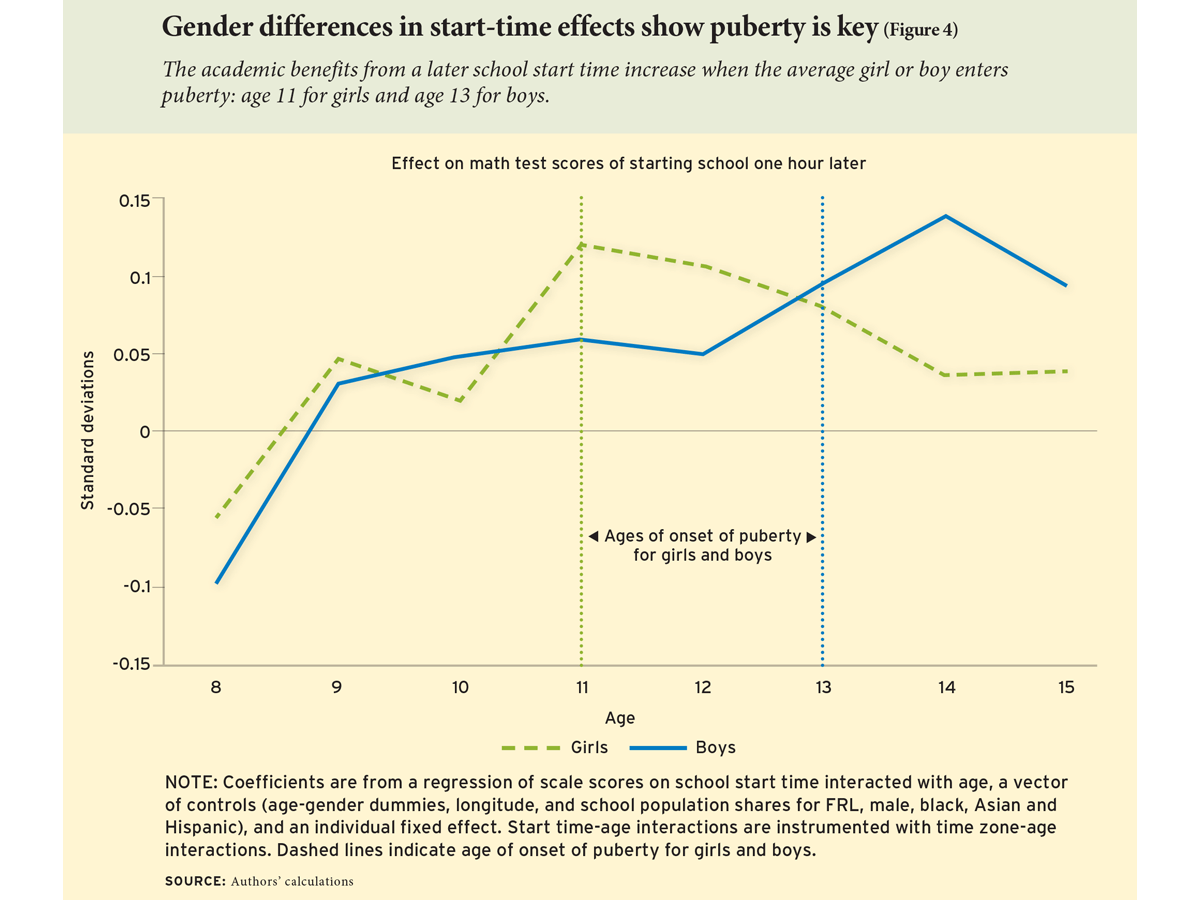 American teenagers are chronically sleep-deprived. As children enter puberty, physiological changes delay the onset of sleep and make it more difficult to wake up early in the morning. By the end of middle school, there is a large disconnect between biological sleep patterns and early-morning school schedules: one study found that students lose as much as two hours of sleep per night during the school year compared to the summer months, when they can better control their sleep schedules.
American teenagers are chronically sleep-deprived. As children enter puberty, physiological changes delay the onset of sleep and make it more difficult to wake up early in the morning. By the end of middle school, there is a large disconnect between biological sleep patterns and early-morning school schedules: one study found that students lose as much as two hours of sleep per night during the school year compared to the summer months, when they can better control their sleep schedules.
Such deficits may have big implications for learning and cognition. Important memory formation and consolidation processes occur overnight, as the brain replays patterns of activity exhibited during learning. Insufficient sleep also reduces alertness and attention levels the next morning, which likely affects students’ ability to learn. Both the American Academy of Pediatrics and the American Academy of Sleep Medicine recommend that high school start no earlier than 8:30 a.m. But most U.S. high schools—87 percent, at the last count in 2015—begin earlier.
Could something as simple as changing when school starts each day really make a difference in how much students learn? And which students would benefit most from a later start time? We consider differences between sunrise and school start times among a group of public schools in northern Florida’s “Panhandle,” which straddles the central and eastern time zones. In this region, sunrise times differ, but school start times do not fully adjust for this difference. Students may start school at the same hour on the clock but not at the same “time”—those in the later time zone could have as much as one additional hour of early-morning daylight before school compared to their neighbors in the earlier zone. How does this affect their performance in school?
We compare test scores for students between the ages of 8 and 15 who move from one time zone to the other and find substantial differences, especially for adolescents. A one-hour delay in start times relative to sunrise increases math scores by 8 percent of a standard deviation for adolescents—the equivalent of roughly three months of student learning—but by only 1 percent of a standard deviation for younger children. The effects on reading scores are similar, but smaller. The benefits of starting school later increase sharply at age 11 for girls and 13 for boys—the gender-specific ages when puberty typically begins, which we take as evidence that the causal pathway is linked to biological changes that affect students’ sleep.
Our findings are the first to quantify the potential academic benefits of changing high-school start times—a seemingly straightforward policy that districts can find difficult to implement (see “How To Make School Start Later” in this issue). If districts in the Florida Panhandle started high schools later and elementary schools earlier, math and reading scores would increase by 6 percent and 4 percent of a standard deviation for high-school students, respectively, with negligible effects in younger grades. Rather than focusing on the disruptions associated with schedule changes, district and community leaders may wish to consider the ongoing costs of not adjusting schedules that are out of sync with sleepy teenagers’ physiological needs.

Sunlight, sleep, and puberty
The role of sunlight in determining sleep schedules is well known. In the morning, light on the outside of the eyelids suppresses production of the hormone melatonin and stimulates brain processes to increase alertness; darkness at night increases melatonin levels and feelings of tiredness. This process changes during adolescence: as children move through puberty, nocturnal melatonin secretion is delayed several hours relative to adults and younger children and sleep patterns become more owl-like, with later bedtimes and wake times, even holding the level of darkness fixed. Teenagers’ sleep patterns, therefore, are linked partially to sunrise and sunset times rather than to clock time.
This means that in terms of student sleep and alertness, the policy-relevant variable is “relative start times,” or start times relative to sunrise time. This becomes an important distinction when comparing schools in different locations, especially those near a time-zone boundary. Suppose that there are two schools close together but on opposite sides of the boundary, where the sun rises at 6 a.m. in central time and 7 a.m. in eastern time. If both schools begin classes at 8 a.m. local time, students attending the school in central time will have one more hour of sunlight before the morning bell compared to their neighbors in eastern time.
This scenario occurs in the Florida Panhandle, an area in the northwestern part of the state that includes the boundary between the eastern and central time zones (see Figure 1). While most of Florida is in the eastern time zone, the western half of the Panhandle is one hour behind in the central time zone. Thus, we have a natural experiment: do students living in the central time zone, who have as much as one additional hour of daylight before school each morning, do better in school than those living in the eastern time zone? Is this effect different for students of different ages? In particular, does it increase as students enter puberty?
To answer these questions, we track the academic achievement of individual students who move between schools on different sides of the time-zone boundary. As students move from central to eastern time, they are exposed to less sunlight before school, which we expect will decrease academic achievement. Conversely, students who move from eastern to central time gain sunlight before school and should see their test scores increase.
Data and methods
Our student and school data come from the Florida Department of Education administrative records for the 15 school years from 1998–99 through 2012‒13, and include all schools except alternative schools, adult education centers, and virtual academies. The data allow us to follow individual students over time, as long as they remain within the Florida public-school system. We look at scores on the annual Florida Comprehensive Assessment Test in math and reading, which students take in various years between grades 3 and 10, as well as students’ race, ethnicity, gender, eligibility for free or reduced-price school meals, and absentee rates. We use birthdays to calculate students’ ages at the start of the school year in September and include all students ages 8 to 15. We approximate students’ entry into puberty using the median age of 11 for girls and 13 for boys, according to data from the National Health and Nutrition Examination Survey.
Our study focuses on students who live near the time-zone boundary and make a substantial move, which we define as consecutive appearances at schools farther than 25 miles apart. Overall, the data show that movers are similar, but not identical, to students who do not move. They come from nearly identical schools, and those moving from west to east are similar to those moving from east to west. Compared to students who do not move, movers are 11 percent more likely to qualify for free or reduced-price school meals and have somewhat lower test scores—0.09 and 0.08 standard deviations lower in math and reading, respectively.
In looking at each group’s pattern of achievement in the years leading up to the move, we find that trends in test scores are similar for movers and non-movers. Among movers, the time until they move is also not a very strong predictor of academic achievement; that is, we find almost no difference in achievement between the year when a student moves and the year immediately before. This suggests that the groups are on similar underlying trajectories, and that any variation in post-move outcomes can be attributed to changes in sunlight before school.
Even so, it is the case that the vast majority of cross-boundary moves are over a great distance, and these moves may impact student outcomes independent of the change in relative start time. We address this concern by including in our analysis students who move schools, but not across the time-zone boundary. This allows us to disentangle the effect of moving from the effect of moving across a time-zone boundary.
To determine schools’ start times, we collected schedule data from their websites and followed up with phone calls where that information was not available. We exclude homeroom and breakfast programs to define school start time as the start of the first class where learning takes place, and find they range from 7 a.m. to 9:30 a.m. local time. The overall average in the Panhandle region is 8 a.m., in line with the average start time nationwide. Median start times for students vary by age: elementary students start at 7:55 a.m., middle-school students at 8:25 a.m., and high-school students at 7:50 a.m.
We use school-location data from the National Center for Education Statistics to calculate sunrise times for each school. Combining these with our start-time data, we average the difference over the school year before the testing date to construct a measure of relative start time, measured as the number of minutes between sunrise and school start times. Although school start times may differ across the time-zone boundary, they don’t differ enough to erase the one-hour difference in sunrise times.

To confirm that the time-zone students live in matters for how much sunlight they experience before school, Figure 2 plots relative start times in the years before and after a move for two groups of students: those who moved east to west, and those who moved west to east. We find that as expected, students in central time have more sunlight before school than those in eastern time. In addition, when students move across the boundary, they are affected immediately by the start time of their new time zone.
The relationship between time zone and relative start times differs for younger and older students. Younger children in the eastern time zone have about 25 fewer minutes of sunlight before school than their counterparts in the central time zone, while the difference for adolescents is 41 minutes. In each case, the difference is less than one hour, or what we would expect if all schools opened at the same clock time on both sides of the boundary. We take this as evidence that policymakers faced with later sunrise times may shift school start times later to compensate, and that they may differentially shift elementary-school start times to prevent younger students from waiting for the bus in the dark.
Tracking start times and impacts
 We conduct various analyses to explore how start times affect students in terms of their academic performance and attendance in school. On the whole, we find that later school start times increase student achievement on standardized tests in both math and reading. However, the size of those effects varies by students’ ages, with the biggest increases among adolescents in math.
We conduct various analyses to explore how start times affect students in terms of their academic performance and attendance in school. On the whole, we find that later school start times increase student achievement on standardized tests in both math and reading. However, the size of those effects varies by students’ ages, with the biggest increases among adolescents in math.
In math, later relative start times increase adolescent students’ scores by 8 percent of a standard deviation, and younger students’ scores by 1 percent to 2 percent of a standard deviation (see Figure 3). In reading, moving start times one hour later increases scores by 6 percent of a standard deviation for both adolescent and younger students. Given that students tend to gain between one quarter and one third of a standard deviation of achievement each year in elementary and middle school, these are substantial effects.
The fact that puberty begins about one and a half years earlier for girls than for boys provides an important testable prediction: if the increasing importance of start times for math performance is a function of puberty, the effect sizes should grow in importance as a larger share of the gender enters puberty. This is precisely what we see.
We find a sharp spike in the effect of school start times on math scores at age 11 for girls, their median age for the start of puberty (see Figure 4). The effect of later school start times is statistically significantly different from zero for girls ages 11 to 13, but not for girls age 10 or younger. We also see an increase in the effect of start times on boys around age 13, their median age for the start of puberty. The effect on math scores is statistically indistinguishable from zero for ages 8 to 12; at age 13, it jumps to nearly 10 percent of a standard deviation from 5 percent. This is evidence that the increasing importance of start times with age is driven by the onset of puberty rather than other academic or behavioral changes.

We also investigate differences among students based on their race, ethnicity, and socioeconomic status, and find more similarities than differences. This suggests that changes to start times will affect all students rather than just certain demographic groups. We also look at whether start times have a transitory or permanent effect on academic achievement and find that the short-term and long-term effects of later start times are similar to one another. In the long run, the effect is larger for adolescents than for younger students in both subjects, although the difference is not statistically significant in reading. The bottom line is that changes to start times improve math and reading achievement within a year of the change in sunlight exposure for adolescents, and the effects largely persist over time.
Showing up ready—or just showing up?
There are (at least) two reasons why school start times might affect academic achievement. First, later start times relative to sunrise may make it easier to get to school on time, reducing absences and increasing time spent on instruction. Additionally, more sunlight before school may improve cognitive function by increasing sleep levels and alertness.
We explore the first possibility and conclude that it is unlikely that reductions in absences are a major causal channel through which later relative start times translate into improved test scores. While later start times decrease absences for younger students, there is no statistically significant relationship between start times and absence rates for adolescents.
The evidence is somewhat stronger in favor of sleep and alertness as the causal channel. To determine the effect of the time-zone boundary on sleep, we use time-use diaries for students collected by the Panel Study of Income Dynamics, which has tracked a nationally representative sample of families and their offspring since 1968. We estimate hours of sleep for children within 400 miles of the central and eastern time-zone boundary and find that prepubescent children in eastern time get 6 minutes less sleep per night during the week than children in central time. The difference in sleep is reversed on the weekend, as they attempt to correct the sleep deficit; students in eastern time sleep 4 minutes longer. After the onset of puberty, both gaps widen: children in eastern time get 17 minutes less sleep per night during the week, and try to compensate with 13 minutes more sleep per night on the weekend.
In short, children in eastern time are more sleep-deprived than children in central time and this gap increases in adolescence. It is therefore plausible that moving from eastern to central time increases both sleep and test scores (and increases them more for adolescents), suggesting that levels of sleep and alertness in the morning are important causal channels through which later school start times increase achievement.
The test-day effect
Increased sleep and alertness could likewise improve test scores in two different ways: improved learning in the year leading up to the test, or better testing performance caused by more alertness on the day of the test. Our approach so far has been to estimate the combined effect of learning and testing. What about students’ alertness on test day?
During the study period, testing dates moved twice: first, from late February to early March, and again to mid-April. This changed levels of sunlight on the day of the test, but had only a small effect on average sunlight levels during the school year, when learning occurred. These policy changes enable us to isolate the effects of alertness on the specific day tests were administered.
From 2000 to 2007, students took tests in February, before daylight saving time began. In 2008‒09, test days were in March, immediately after the start of daylight saving time (when clocks “spring forward” and sunrise moves an hour later). And in 2011‒13, students took tests a month later, in April. This changed the amount of sunlight before the tests: in eastern time, the average was 1 hour 20 minutes in the earliest era, which dropped to 28 minutes after the first change. After the second change, when the test was moved one month later, the amount of sunlight before school on the testing day increased to an average of 1 hour 9 minutes. Based on these differences, we group together 2000‒07 and 2011‒13 into a “late test time” treatment era, and 2008‒09 into an “early test time” treatment era.
Does the effect of relative start times on achievement change depending on test-day sunlight? We find no evidence of a testing day effect in math, but do find suggestive evidence in reading.
In math, moving start times one hour later increases achievement by nearly 10 percent of a standard deviation in both eras for adolescents. In reading, the effect during the relatively earlier testing era is 10 percent of a standard deviation per hour of sunlight compared to 5 percent in the later-start era—a statistically significant difference, which suggests that test-day sunlight may be important for reading achievement.
There is, however, one important reason why the result in reading should be taken with some caution: in the “late test time” era, students took tests almost immediately after the switch to daylight saving time, when they can lose up to an hour of sleep. We therefore interpret the differences as related to differences in sunlight time before school and up to an hour of sleep deprivation.
The safest interpretation, in our view, is for moderate test-day effects in reading of the same order as the full-year learning effects. But we note that our results for start-time effects tied to adolescence are strongest for math, for which we do not find any evidence of test-day effects.
Benefits of rearranging start times
School districts often open different types of schools at different times in the morning. These staggered start times allow districts to use the same buses more intensively, saving on transportation costs. However, high schools typically start first, followed by middle and then elementary schools, which runs counter to research and recommendations from leading medical groups.
What would happen if the districts in our study flipped school start times so elementary schools opened earliest, followed by middle and then high schools? We create this hypothetical scenario by reassigning average start times in each district based on this pattern, which moves elementary start times 22 minutes earlier, middle schools 13 minutes earlier, and high schools 44 minutes later.
We estimate the effects on test scores, including by gender and race, and find adolescents would experience large and statistically significant gains: in math, the proposed policy would increase minority student achievement in high school by 6 percent of a standard deviation in math and 8 percent of a standard deviation in reading. For white students, we expect that math scores would increase by 6 percent of a standard deviation and reading scores by 2 percent of a standard deviation. Male high-school students would benefit slightly more compared with females, but that difference is not statistically significant.
The effects for younger students are negative, but much smaller in size: on average, reading and math scores for elementary and middle-school students would decline by roughly 1 percent of a standard deviation across all student subgroups. Moreover, the high school results are good estimates for the overall potential change in achievement for each student by the end of high school.
Implications
Despite growing medical and physiological evidence that current school start times are too early for optimal adolescent cognitive functioning, there has been little policy response to move start times later. We add to this debate with direct evidence that more sunlight before school—or a later relative start time—increases academic achievement for children of all ages. Further, these effects are cost-effective compared to other proposals to improve educational achievement, such as making classrooms smaller: changing school schedules is estimated to cost $150 per student per year, whereas reducing class sizes by one third costs approximately $6,200 per student per year. There may be other changes in time use resulting from changed start times—research indicates that later start times coincide with less time spent on extracurricular activities, as well as more leisure time for girls and computer use for boys. But it is difficult to reconcile the patterns of achievement by developmental status with an explanation not revolving around the transition to puberty. More importantly, from the perspective of a policymaker, the distinction is moot, since changing school start times necessarily affects both before- and afterschool time.
Our research shows that adjusting school start times so that high school students have the latest start time would significantly increase achievement for older children at a very low academic cost for younger children—who will more than make up for this cost when they grow older. Even when start times are reordered so that the average start time across the district remains the same, there are non-trivial gains in average academic performance that would benefit students in all demographic groups. These gains must be weighed against the concerns and criticism that typically accompany such schedule-change proposals.
Jennifer Heissel is assistant professor at the Graduate School of Business and Public Policy at the Naval Postgraduate School. Samuel Norris is assistant professor at the Harris School of Public Policy at the University of Chicago. The authors’ views do not represent those of the United States Navy or Department of Defense.
For more, please see “The Top 20 Education Next Articles of 2024.”
This article appeared in the Summer 2019 issue of Education Next. Suggested citation format:
Heissel, J., and Norris, S. (2019). Rise and Shine: How school start times affect pandemic performance. Education Next, 19(3), 54-61.


